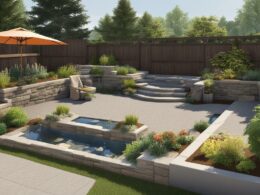Are you tired of spending endless hours maintaining your grass? Artificial turf may be the solution for you. Not only is it low-maintenance, but it also looks great year-round. In this section, we will provide you with an easy-to-follow guide on how to put turf in your backyard.
Key Takeaways:
- Installing turf in your backyard is a great low-maintenance option.
- Our step-by-step guide will walk you through the process from start to finish.
- With these tips, you can achieve a professional-looking result on your own.
Preparing the Area
If you want to install turf in your backyard, you need to start by preparing the area properly. Follow these steps to ensure that your DIY backyard turf project turns out great:
Step 1: Remove Existing Grass
The first step is to remove any existing grass or vegetation in the area where you plan to install the turf. You can use a sod cutter or a shovel to remove the top layer of grass and roots.
Step 2: Level the Ground
Once you have removed the grass, you need to level the ground. Use a rake or shovel to remove any rocks, bumps, or debris that might affect the turf’s installation. Make sure to create a smooth and even surface that will serve as the base for the turf.
Step 3: Address Drainage Issues
One of the most important things to consider when preparing the area is drainage. You want to make sure that the turf has proper drainage so that it doesn’t become waterlogged or develop mold or mildew. Create a slight slope in the ground to ensure that water drains away from the area or install a drainage system if necessary.
By following these steps, you will lay the groundwork for a successful backyard turf installation. Taking the time to prepare the area before installing the turf will ensure that you have a smooth, even surface that will look great and last for years to come.
Installing the Turf
Now that you’ve prepared the area, it’s time to install the artificial turf in your backyard. Follow these steps for a successful installation:
- Unroll the turf and let it acclimate to the environment for at least one hour.
- Cut the turf to fit the area, leaving a little extra around the edges to be trimmed later.
- Join multiple pieces of turf together using adhesive or stakes.
- Trim the edges of the turf to fit your space perfectly.
- If necessary, add infill material between the fibers to improve stability and prevent wrinkles.
- Use a power broom or leaf blower to fluff up the fibers, making them stand upright for a more natural look.
Remember, it’s important to handle the turf with care during installation to prevent wrinkles or damage to the fibers. Following these steps will help ensure a smooth and successful installation of your new backyard turf!
Finishing Touches
Now that your turf is installed, it’s time to add the finishing touches to ensure it looks and performs its best for years to come. Here are some tips:
Brush the Turf
After the installation is complete, brush your new turf with a stiff bristle broom. This will make the fibers of the turf stand up and give it a more natural look. Do this regularly to maintain the appearance of your turf.
Add Infill
Infill is a material that is added to the turf to help it stand up and provide additional stability. It can also help with drainage. Make sure to choose the right type of infill for your turf and add it according to the manufacturer’s instructions.
Regular Maintenance
Maintaining your new turf is easy. Simply rinse it with a hose occasionally to remove any debris. You can also use a leaf blower to remove leaves and other small debris. If you have pets, be sure to pick up any solid waste and rinse the area thoroughly with water to avoid any odors.
Tip: If your turf has wrinkles or areas that are not laying flat, don’t worry! Simply use a weighted roller to flatten them out.
By following these final steps, you can ensure that your new turf looks and performs its best for years to come. With regular maintenance, it will provide a beautiful, low-maintenance space for you to enjoy for many seasons.
Conclusion
Congratulations! You have successfully installed artificial turf in your backyard. Not only have you saved money on lawn maintenance, but you have also created a beautiful, low-maintenance outdoor space where you can relax and enjoy the outdoors.
Remember to regularly brush your turf to keep it looking natural and add infill as needed to improve stability. With proper maintenance, your artificial turf can last for many years to come.
FAQ
Q: Can I install turf in my backyard myself?
A: Yes, you can install turf in your backyard yourself by following our easy step-by-step guide.
Q: Do I need to remove the existing grass before installing turf?
A: Yes, it is important to remove the existing grass to ensure a smooth and level surface for the turf.
Q: How do I level the ground in preparation for turf installation?
A: You can level the ground by removing any rocks or debris, filling low areas with topsoil, and using a rake or roller to create an even surface.
Q: What should I do about drainage issues in my backyard?
A: If you have drainage issues, it is important to address them before installing turf. You can consider adding drainage pipes or creating a slope to ensure proper water flow.
Q: How do I measure and cut the turf for installation?
A: To measure and cut the turf, use a tape measure to determine the dimensions needed and a utility knife to cut the turf to the desired size.
Q: Should I use adhesive or stakes to secure the turf?
A: The choice between adhesive or stakes depends on personal preference and the specific requirements of your backyard. Adhesive provides a more permanent solution, while stakes allow for easier removal if needed.
Q: How do I join multiple pieces of turf together?
A: To join multiple pieces of turf, use adhesive or special joining tape to create a seamless and secure connection.
Q: How do I make the turf look more natural?
A: Brushing the turf with a broom or power brush will help the blades stand upright and create a more natural appearance.
Q: Should I use infill for my turf?
A: Adding infill, such as sand or rubber granules, can help improve stability and provide cushioning for the turf.
Q: How do I maintain my turf after installation?
A: Regular maintenance for your turf includes brushing to remove debris, occasional spot cleaning, and rinsing with water to keep it looking fresh.









